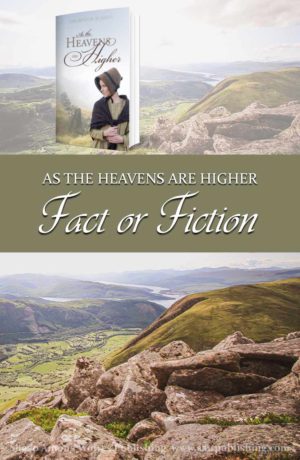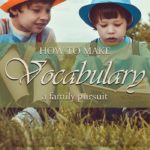As the Heavens Are Higher: Fact or Fiction

“Did you base As the Heavens Are Higher on a true story?”
If my life had a FAQ page, this one would be pretty near the top. (Ranking second to “How are you this morning?” and “Did you ever see such a rainy day?” of course!)
The trouble is, when you attempt to answer this kind of question for historical fiction, your FAQ page ends up turning into a full-length thesis paper. Because the answer isn’t yes—but it isn’t no, either.
As the Heavens Are Higher is primarily fictitious—that is to say, the main characters and events were created for the sake of the story. However, there’s a lot of real-life material that slipped in during the writing process. And today, I want to share some of that with you.
 Real-Life Inspiration
Real-Life Inspiration
On the other side of the Atlantic Ocean, at the end of a long, narrow road that is almost nothing more than a country lane, shadowed by trees that are more ancient than the New World republics, there stands a tall, grey, gloomy old castle.
Nearly a decade ago, I had the privilege of staying in a guest-house-style apartment in this tall, grey, gloomy old place. You went up a stone staircase that wound round, and round, and round, getting narrower and narrower and narrower, until you almost began to wonder whether you could fit through it if you went much higher up. And then suddenly the staircase stopped, and there was a door, and you had arrived.
It was a fairy tale kind of place, but it belonged very definitively to the beginning of the fairy story—the part before some kind, loving child had come along to spread light and gladness through its dismal old corridors.
Yes, the Highbank Castle of As the Heavens Are Higher is a real place. It doesn’t have that name, of course, but it exists all the same. It is just as grey, and gloomy, and forbidding as it appears in the story. And simply because I, as an author, could not leave that real-life place alone without sketching for myself what might have been, under other circumstances—the first inkling of As the Heavens Are Higher came into being.
Real-Life Backdrops
Highbank Castle is, obviously, the most significant real-life backdrop for As the Heavens Are Higher. Adelaide Westall’s home, on a Northumberland sheep farm, might have been one of many properties in the neighborhood of Highbank, although it does not have a specific prototype in real-life. The same may be said for the village of Chatwick, the orphans’ flat, and Morning Glory Cottage.
Several other locations that form backdrops for specific scenes, on the other hand, are drawn more or less literally from places that actually do exist. The De Fontes’ pele tower—a unique architectural feature of the British border counties—and the rugged slopes of Broomhill Craig appear with changed names, but are closely modeled from real life.
The railway station in Chathill, and Alnwick Castle, on the other hand, are entirely factual places and have been drawn, to the best of my ability, as they appear today—and very similarly to how they would have appeared in Adelaide’s time.
Real-Life Incidents
Then there are the tiny tidbits of real-life happenings that somehow found a place in the story, too. The most significant is the legend of a secret tunnel that supposedly connects Highbank Castle with a distant tower. In real life, this passage began to collapse when the modern owner attempted to explore it, so the details of the legend remain a mystery. In the story, on the other hand . . . well, you’ll just have to wait and see!
The Highbank Castle clock, that loses thirty seconds (or thereabouts) a day is also founded on fact. I have met the faithful man who climbs to the top of the clock tower every-other-day to correct the time, so that it always appears accurate despite the faulty mechanism.
I sometimes also find single sentences or phrases from real people slipping into my characters mouths. For instance, the toddler’s request, “Pick you up,” was something one of my siblings used to say when they were too little to realize that “you” wasn’t a nickname for themself.
Real-Life Historical Details
And then the final place I love to borrow details from is historical non-fiction.
Aunt Eliza’s stain-removal techniques and Adelaide’s Queen Cakes recipe were both taken from 19th century housekeeping manuals. So was Lady Bradstock’s story about the lady who spilled plumb preserves on her hat—although I have to admit I am a bit skeptical as to whether the prescribed “cure” always works as well as the writer claims!
The rhyming epitaph that appears part way through the story is also from real life and can be found in slightly varying forms on numerous historic tombstones.
A number of old hymns and poems from Victorian or pre-Victorian authors have been used throughout the book—that may add to the historical flavour, but I’ll have to admit I’d probably have put old hymns into a modern story, too. As most of you already know, I just love hymns!
So is it a True Story?
At the end of the day, historical fiction is still fiction. It’s the product of an author’s imagination, rather than a record of real life as it actually occurred.
But almost all fiction has at least part of its roots in fact. As you can see, there are plenty of true stories woven into the pages of As the Heavens Are Higher.
I can’t wait to share them with all of you—and we’re getting very, very close! Join us next Monday morning for the official release!
To learn a little more about the setting and storyline of As the Heavens Are Higher see our previous post:

Is it actually worthwhile to invest precious hours reading your children’s books? Here are three reasons to make the effort—and build a legacy you will never regret.

We all recognize the importance of a good vocabulary, but intentionally cultivating it can be another question. SAW Publishing’s Word of the Week (WOW) program is the perfect starting place.

What do we mean by a great book? What makes literature truly great? How do you recognize outstanding literature when you find it?


OH COUTRTNEY! I CAN’T WAITTTTT!! 😀 😀
Thanks, Katja!
It was fun learning more about your book! I can’t wait for the release!
Thanks, Lilly!